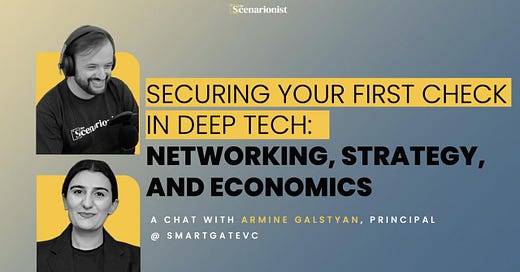Welcome to the 71st edition of Deep Tech Catalyst, the channel by The Scenarionist, where science meets venture!
Today, we’re joined by Armine Galstyan, Principal at SmartGateVC!
Whether you’re a technical founder, a researcher transitioning to entrepreneurship, or an early-stage team navigating the complexities of building in deep tech, this conversation offers practical insights into one of the hardest parts of the journey: translating your breakthrough into a clear, compelling value proposition.
From securing warm intros to communicating with investors, and from unit economics to realistic market modeling, Armine shares how early-stage founders can shift their mindset—from showcasing a technology to articulating a company.
In particular, we explore:
How to navigate early investor conversations as a STEM founder
What investors actually look for in pre-product deep tech companies
How to avoid common pitfalls when estimating market size and penetration
Why storytelling, segmentation, and strategic thinking matter more than perfect metrics in the earliest stages
Let’s dive in. 🎯
✨ For more, see Membership | Deep Tech Briefing | Insights | VC Guides
BEYOND THE CONVERSATION — REFLECTIONS & STRATEGIC INSIGHTS FROM THE EPISODE
Crafting a Strong Value Proposition in Pre-Revenue Deep Tech
In today’s discussion, we focus on how deep tech founders—particularly at the pre-revenue or pre-seed stage—can effectively articulate a compelling value proposition.
This becomes especially critical when the founders come from technical backgrounds and need to translate their innovations into business language that resonates with investors.
Every startup must lead with a value proposition. It’s not enough for a product to work—the founder must be able to communicate why it matters, especially when engaging with venture capitalists (VCs).
Let’s start with the basics: how to approach a VC and communicate your value proposition effectively—what works, what doesn’t, and how to stand out.
Networking 101: Warm Introductions Always Work Better
The most important principle in venture outreach is simple: a warm introduction dramatically increases your chances of success. Investors are far more likely to engage with a founder who comes recommended by someone they trust.
There are several ways to get this kind of introduction:
From other founders: One of the most effective sources of warm intros is a founder already backed by the VC. Portfolio founders understand what their investors are looking for and can vouch for you directly.
From limited partners (LPs): LPs—those who have invested in the VC fund—can also make valuable introductions. If you meet an LP and they find your idea compelling, they might introduce you to the fund’s partners.
The core strategy is to build relationships with other founders and operators. Not only can they relate to your challenges, but they also tend to have strong networks and may eventually introduce you to relevant investors.
Why Warm Introductions Matter More Than Cold Emails
When a warm introduction comes from a trusted source—whether it’s a portfolio founder, a limited partner (LP), an angel investor, or another VC—it serves as a form of early validation. It communicates more than just interest; it conveys belief.
In many cases, these introducers have known the founder for years—sometimes having worked together across multiple companies. That kind of history provides data points about a team’s character, reliability, and capability before a single meeting even takes place.
Data Builds Confidence—and Speeds Up Decisions
Early-stage investing is inherently relationship-driven. Decisions are made with limited data, especially in pre-revenue or deep tech contexts where traction is hard to quantify. That’s why any credible signal—like a warm intro from someone the VC already trusts—carries significant weight.
It’s not just about who makes the introduction. It’s also about the context and the relational capital behind it. These connections provide an investor with a richer picture of the founder before the first conversation ever happens.
In simple terms: warm introductions offer trust, credibility, and pre-vetted insights. All of which make the investment process smoother, faster, and less risky.
The Worst Approach: Mass Messaging
On the opposite end of the spectrum, the least effective approach is sending mass emails or blanket LinkedIn messages. Venture firms receive hundreds of these every month. While some partners make an effort to review them, it’s extremely rare for these cold messages to result in a meeting—especially if the outreach isn’t aligned with the firm’s focus.
This isn’t about being ignored. Many cold emails are read. The issue is relevance. Most messages are either too generic or completely misaligned with the fund’s investment thesis.
If You Must Cold Email, Do It Thoughtfully
If a warm introduction isn’t available and you decide to reach out cold, the key is research. Avoid the shotgun approach. Instead:
Identify firms that invest in your specific domain.
Find the partner at the firm who is most relevant to your technology (e.g., robotics, biotech, etc.).
Tailor your message. Make it clear that you understand what the firm looks for and why your company aligns with their strategy.
Doing this homework pays off. A well-crafted, personalized email to the right partner is far more effective than sending a generic message to 50 random investors.
Articulating a Vision at the Earliest Stage
After identifying the right investor and securing a warm introduction, the next step is critical—presenting your idea. For many deep tech founders, especially those from STEM backgrounds, this can be a major hurdle. You may have a promising technology or early-stage research, but no finished product.
How do you convey the value of your company to an investor at this stage?
The answer lies in how well you articulate a compelling vision and value proposition—a narrative that connects your technical innovation to a future product, a market need, and a meaningful impact.
Why Some of the Best Investments Start Before the Company Exists
Before diving into tactics, it's worth noting a nuance often missed: not all great investments come from warm intros or inbound pitches. In fact, some of the best opportunities come from outbound sourcing—when investors actively scout talent.
In many cases, VCs will identify promising researchers or technologies before a company has even been formed. This happens through university lab visits, early-stage conferences, or referrals from academic circles. Investors build relationships over time—working with the scientists or engineers behind the tech to shape it into a business.
This is a powerful reminder: You don’t need to wait until you’re “ready” to start building investor relationships. If you’re working on something interesting, start having conversations early. The best investors often want to be involved before others are even paying attention.
The 3 Essentials Investors Look For in Early Deep Tech
Once you're in the room—or on the call—the question becomes: what should you focus on in the first meeting, especially if you don’t yet have a marketable product?
Here’s the investor perspective:
1. Team First: Who Are You, and Why You?
In deep tech, early-stage investments are mostly bets on people. When you're still pre-product, the most critical asset is your team.
Who are the founders?
What is their technical expertise?
What makes them uniquely qualified to commercialize this innovation?
Investors want to hear your origin story—why you care about the problem you’re solving, what insights you bring, and what makes you credible in the space. This goes beyond resumes. It’s about conviction, clarity, and trust.
2. Technology: What Are You Building—and Why Does It Matter?
While the team is the primary focus, your technology is the second pillar. But the key here is not to overwhelm investors with technical complexity. Instead, articulate:
What makes the tech novel or defensible (e.g., IP, research depth, scientific breakthrough)?
What real-world problem might it solve?
Why does that problem matter, and for whom?
At the pre-seed stage, many founders haven’t yet matched their tech with a well-defined market problem. That’s okay. But showing an intent to move in that direction—and a clear willingness to iterate—matters a lot.
3. Traction (If Any): Even Signals Matter
At this stage, actual traction is rare. But if you have early signals—letters of interest, research grants, customer conversations, prototype contracts (especially with governments or agencies)—these are valuable.
You don’t need a full go-to-market plan. But even light validation shows momentum and helps investors gauge potential fit and interest from real-world stakeholders.
Don’t Confuse Technology with Products
One of the most common early mistakes technical founders make is equating technology with innovation.
The reality is: innovation is about creating impact—solving a clear, real-world problem in a way that users, customers, or stakeholders care about.
So when crafting your pitch, avoid over-indexing on the complexity of the science. Instead, lead with your vision, supported by a credible path to value. Focus on how your technology becomes the engine behind something meaningful.
Making the Numbers Work: Market Size, Unit Economics, and Investable Narratives
Once you've established a compelling team and an early vision, investors will naturally begin to look for the third leg of the stool: the numbers.
Even in the pre-revenue stages of deep tech, where commercialization may still be years away, investors need to understand whether the opportunity has the potential to scale.
That said, not all numbers matter equally at this stage. Some are essential, some are helpful, and others are simply irrelevant. Here’s how to tell the difference—and how to build a credible, investor-ready case.
What Numbers Actually Matter in the Early Stage
1. Product Advantage Metrics
These are critical. Any quantifiable way to show how your technology is superior helps investors quickly grasp its value. These might include:
How many times faster, smaller, or more energy-efficient your solution is.
How much cheaper or more accurate your product can be compared to existing alternatives.
Especially in hardware, deep tech, or scientific applications (e.g. radar, LiDAR, biotech instrumentation), these performance-based deltas form the backbone of your value proposition.
2. Founder Track Record
Quantify your team’s experience:
Years in relevant technical roles.
Number of successful projects, publications, or previous ventures.
Any direct experience building or scaling similar technologies.
Investors want to know they’re backing people who’ve done the work before—or who are deeply embedded in the problem space.
Understanding Unit Economics in Pre-Revenue Deep Tech
Start with: What Is a “Unit”?
Before calculating unit economics, define what the “unit” is for your business:
Hardware: Is the unit a single device sold or rented?
Software: Is it priced per user, per month, or via enterprise licensing?
Platform: Is it a combination of services, integrations, or data access?
Once you define your unit, you can begin outlining its core economics.
Key Components of Unit Economics
Revenue per unit: What will you charge?
Cost per unit: What does it cost to produce, deliver, or maintain that unit?
Profitability at scale: Will this model be profitable per unit once scaled?
At this stage, you're not expected to have precision. But demonstrating that you've thought through a path to profitability—and that it scales—is a signal of maturity.
Ignore fixed costs for now; focus on variable unit-level economics.
Calculating Market Size
One of the most common mistakes founders make is calculating market size top-down. These pitches usually sound like this:
“There are 1 billion cars in the world. If we capture just 1%, that’s a $10B business.”
This is rarely helpful. It’s too vague and disconnected from how markets actually behave.
A Better Approach: Segmentation and Bottom-Up Modeling
Start by identifying a specific use case or pain point your product addresses. Then work backward to define:
The exact segment of customers who face that problem.
How many companies (or users) are in that segment?
The price you would charge each.
The frequency of purchase (once, annually, monthly, etc.).
Market Penetration Rate
One of the most common challenges for early-stage deep tech founders is how to estimate market potential, especially when their product hasn’t reached the market yet.
Unlike consumer startups or SaaS platforms, where performance metrics emerge quickly, deep tech companies often require longer timelines and more nuanced thinking to articulate the opportunity ahead.
So how do you build a credible case when you can’t show revenue or penetration yet? And how do investors interpret these numbers?
What VCs Actually Want to Know About the Market
Some deep tech innovations target narrow markets. A product might be brilliant and necessary—but if hospitals only buy it once per decade, that’s a small annual market. In those cases, even with great margins and strong tech, it may not be a fit for venture capital.
That doesn’t make it a bad business—just not necessarily a VC-scale business.
These types of companies can still succeed via early strategic acquisition—especially if their innovation fills a gap in a broader product portfolio.
That said, at the pre-seed and seed stage, investors typically aren't looking for precise year-by-year projections. Instead, they want to understand whether the potential size of the opportunity is big enough to justify venture backing.
When early-stage investors ask about market size, they’re not expecting founders to guess their exact year-three market share.
They’re looking for directional clarity—signals that:
The market is large enough to support a venture-scale outcome (usually $200M+ annually).
The problem being solved is painful enough to generate meaningful demand.
There’s a path to revenue that, once activated, can scale predictably over time.
In other words, focus on showing that the opportunity exists and is worth chasing.
Actionable Market Modeling Tips for Founders
When you’re still in the early stages, here’s how to think about market potential:
1. Start with a Focused Segment
Don’t try to boil the ocean. Identify the specific niche where your product solves a real, acute problem. For example:
Not “all cars” → but “autonomous fleet vehicles operating in dense urban areas.”
Not “healthcare” → but “oncology labs needing subcellular analysis at scale.”
This makes your assumptions more credible and your opportunity more tangible.
2. Use Conservative, Bottom-Up Math
Once you’ve narrowed your segment:
Estimate how many customers exist in that segment.
Multiply by your expected annual revenue per customer.
That gives you a realistic view of Serviceable Available Market (SAM).
3. Avoid Lazy Top-Down Estimates
Avoid generic statements like:
“If we capture just 1% of a $100B market, we’ll be a billion-dollar company.”
This logic doesn’t build investor confidence. Precision matters more than magnitude at this stage.
What to Prioritize Instead
In early deep tech, the most important assets to communicate are:
Team: Expertise, experience, and trustworthiness.
IP: What’s defensible? What can be protected?
Insight into the market: Deep understanding of the use case and buyer.
Go-to-market thinking: Even without revenue, show that you're designing for adoption.
Founders who can show strong traction in these areas are far more likely to get funding—even without early revenue.
10 Truths No One Tells You About Building a Deep Tech Team
You don’t scale science. You scale people.
Too often, founders in deep tech think that what they’re building is the business. They obsess over the hardware. The chemistry. The experimental model. The lab result. And in doing so, they treat the team as a checkbox slide on their pitch deck—when it should be the main event.
If this sounds like you, take a breath. You’re not alone.
But it’s time to change how you think about team-building in deep tech—because that’s where investors are placing their bets. Not just on what you’ve built. But on who is building it.















